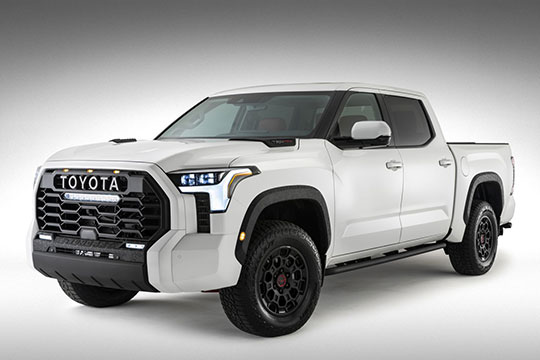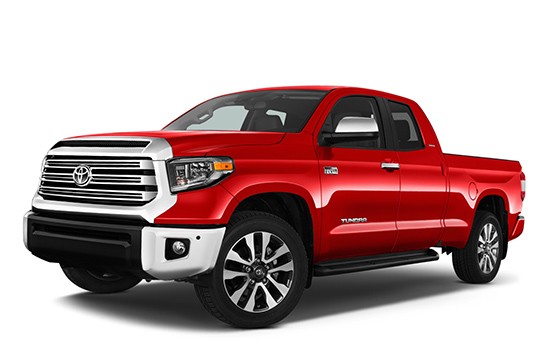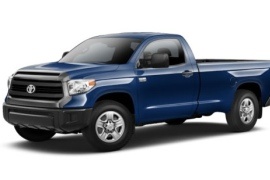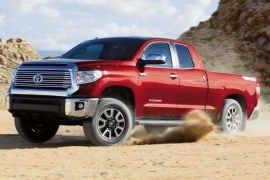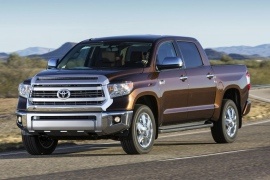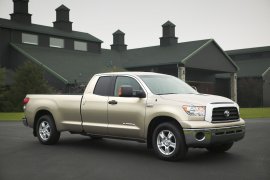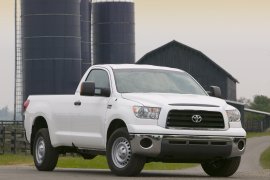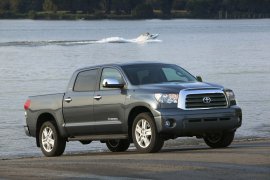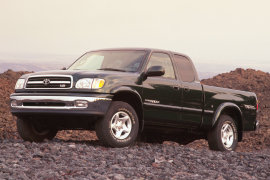TOYOTA Tundra Models/Series Timeline, Specifications & Photos
First production year: 1999
Engines: Gasoline, Hybrid gasoline
Body style: Truck
Toyota introduced a completely new Tundra in 2021, after 14 years since the launch of this pickup's predecessor, in 2007, and the seven since the refreshed 2014 model.
The full-size pickup segment is highly competitive in the U.S. market. So Toyota tried hard to convince American customers to ditch the Silverados, the F-150s, the RAMs, or the other Japanese contender, Nissan Titan. Tundra's sales results were not bad, but it never gained the same image as the local manufacturers.
Its rugged appearance is backed up by a redesigned chassis and a proven sturdiness. Toyota designed, engineered, and tested the 2021 Tundra in U.S. Gone were its predecessors' soft lines and curved panels. Instead, the front fascia features a flat, broad grille, which looked more like a barbwire fence, or gate, than a car's grille.
For the interior, Toyota understood that it couldn't compete with the same rugged appearance of its predecessors. It offered the Tundra in six trim levels, ranging from SR5 up to the 1794 limited edition. With the 2021 model year, the customers could enjoy a luxurious cabin adorned by leather upholstery and a 14" infotainment screen that sat atop the center stack.
But the most essential change was on the car's platform. It featured coil springs in the back, ditching the leaf springs. It could still handle 1,950 lbs (884 kg) and tow up to 12,000 lbs (5,443 kg). Under the hood, there was only a twin-turbo V6 powerplant that offered 348 hp for the SR5 version. At the same time, the other options were 389 horses and a hybrid version that provided a combined output of 437 horses and 583 lb-ft (790 Nm) of torque. All versions were paired with a 10-speed automatic transmission and sent the power in all four corners.
Toyota added another refresh for the Tundra’s second generation for the 2018 model year, adding more TRD packages and improving the vehicle’s safety.
After a mild facelift introduced in 2013, the Tundra’s sales were still going strong. Still, customers needed something fresh on the market, so the automaker introduced a second update for the vehicle in 2017 for the 2018 model year at the Chicago Auto Show. While the vehicle was basically the same, there were some upgraded parts both on the exterior and interior. The engine and the drivetrain, on the other hand, remained the same because the automaker considered that it didn’t need any improvements. Its decision was motivated by the million-mile Tundra, a vehicle that was heavily used by a customer between 2007 and 2016 and gathered the seven-figure number on its odometer without any significant technical problems and still running like a champ.
Toyota improved the front fascia of the 2018 Tundra with the addition of LED headlights for higher trim levels, such as the Platinum, the 1794, and the TRD Pro. At the same time, the SR and the SR5 grades were fitted with halogen-based headlamps. Another improvement for the 2018 Tundra was the main grille, which received billet styling or a chromed one. Furthermore, the TRD Pro featured body-colored front and rear bumpers, making the full-size Tundra more street-oriented. Still, the automaker improved the A-TRAC (Active Traction Control) system that featured Limited Slip Differentials on both axles.
From its profile, the 2018 Tundra featured body-colored door mirrors, and customers could also have the car with side steps that eased the ingress and egress. At the back, an integrated step into the rear bumper helped them reach better into the bed. The SR and the SR5 grades came with 18-inch steel wheels, while the upper trim levels featured a set of 20-inch light alloy ones.
The cabin was also upgraded with an improved Optitron instrument cluster, making the dials look larger and more visible to the driver. Depending on the grade, the upholstery was different, and the TRD Pro got its specific pattern for the fabric on all seats. Another essential update was for the infotainment system that adorned the center stack. While the SR and the SR5 got a 6.1” touchscreen for Toyota’s Entune unit, the others featured a 7.0-inch touchscreen and, as an option, a 12-speaker JBL sound system.
However, the most essential upgrade was for the safety systems, including Vehicle Stability Control, Traction Control, Electronic Brake Distribution, Brake Assist, and Smart Stop Technology. In addition, customers could get the 2018 Tundra with the TSS-P (Toyota Safety Sense P) system featuring pedestrian detection, pre-collision, lane-departure warning, and Radar Cruise Control. In the event of a crash, eight airbags were there to protect the passengers.
Under the hood, Toyota installed the same choice of two V8 engines: a 4.6-liter and a 5.7-liter V8, paired with a six-speed automatic gearbox that sent power to the rear or in all corners. In addition, the TRD Pro featured thicker anti-roll bars and Bilstein dampers for better road handling.
Toyota attacked the American pickup segment with the Tundra model. That half-ton vehicle was meant to climb or to haul, no matter the road ahead.
Even if the 2014 model, launched in February 2013, was not a completely new model, only the cabin was kept from the non-facelifted model. The hood was raised for a better stance on the road. Along with that redesigned front end design, the front grille was enlarged. Also, the bed has received few upgrades and even a small spoiler on top of the tailgate. The regular cab was offered with two bed options: a 2.0m (78.7”) and a 2.5m (97.6”), respectively.
Inside, there are more features than before, with a new, redesigned HVAC unit and better controls. Also, there is a new infotainment unit that has a rear-view camera mounted on the tailgate. For the Regular Cab, there are three seats offered, but the middle is very cramped, on top of the transmission tunnel. When that is not used, it can be folded and used as a table with two cup-holders. Behind the seats, there is a decent cargo area, large enough for some fishing equipment.
Under the hood, the same engine range was kept, starting with a 4.0-liter V6. The top version was the 5.7-liter V8 unit. All engines were mated with a 5-speed automatic transmission that featured a switch on the lever for manually selecting the gears. The Tundra was offered as a 4x2 or 4x4 with low-range gear.
The half-ton pickup from Toyota received a good upgrade in February 2013 as a 2014 model. There were big changes, more on the inside than on the outside.
The entire front end of the 2014 model Tundra was changed. A higher grille and hood, larger fenders and oversized bumpers were on the list. There were few choices of designing that grille, depending on the trim level. It could be chromed or black with grey. From the side, the cabin looked the same as the model before the facelift. The Double Cab models were offered with a standard 2.0 m (78.7”) bed or long 2.5m (97.6”) configuration.
The interior was brand new. A new dashboard, new center console, and new instrument cluster, which featured a small display for the on-board computer. It had a nice graphic, a step towards a complete TFT display. On the center console, the infotainment unit could be paired with a Bluetooth device and it could be upgraded with a premium JBL sound system. Since the Double Cab was designed as a daily driver for a contractor or a family vehicle, it was offered either with a bench or a two bucket-seats option. In the rear was plenty of room for three passengers.
Under the hood, the same engine range was kept, starting with a 4.0-liter V6. The top version was the 5.7-liter V8 unit. All engines were mated with a 5-speed automatic transmission that featured a switch on the lever for manually selecting the gears. The Tundra was offered as a 4x2 or 4x4 with low-range gear.
Toyota refreshed the second generation of the Tundra after seven years on the market and revealed the facelifted version in 2013 a the Chicago Auto Show.
The Japanese automaker tried to beat the American automakers at their own game, namely the pickup segment. But it had to do that with a range of big, powerful trucks, and the Tundra was designed precisely for that. It was available in a three-cab configuration with either two or four doors. The Crew Cab was the latter version, with room for a family inside and a bed in the back for all the camping gear that they needed.
On the outside, the 2013 Tundra boasted a massive front fascia adorned by chromed trims on the grille. Above it, on the hood, Toyota added a horizontal scoop that brought fresh air to the engine. On its sides, the Crew Cab version of this pickup sported four doors and, obviously, a bed in the back. One noticeable detail was for the bed, which was completely separated from the cabin, thus reducing vibrations sent to the passenger area.
Inside, the Japanese automaker completely redesigned the dashboard. On the center stack, depending on the trim level, the Tundra Crew Cab featured a Bluetooth-compatible sound system with an option for a JBL unit that provided a better listening experience. Behind the wide front seats, Toyota installed a bench seat for three in the back, with plenty of legroom and headroom.
Under the hood, the carmaker offered a choice of two engines: a 4.7-liter V6 and a 5.7-liter V8. Both versions sent their power to the rear or all corners via a five-speed automatic. The latter version also featured a transfer box with high and low gears.
Toyota made an evolution plan for the U.S. pickup market and started with the Tacoma in 1995, which evolved into the Tundra's first generation in 1999.
With the first generation of the Tundra, Toyota learned that it needed a V-8 with over a gallon (3.8-liter) displacement under the hood to be taken seriously by U.S. customers. It was part of its learning curve, and the real deal came in the shape of the Tundra's second generation in 2006.
If Ford had the three-slats grille and the RAM featured the cross-hair, the Tundra sported the trapezoidal grille, which became a brand image. The high-mounted, swept-back headlights and the thick front bumper started to be noticed on the roads. The Tundra looked more like a cab-extended version in the Double-Cab version due to its hidden handles for the rear doors. Only the front ones were oversized, so the driver could open them with a gloved hand. But it wasn't the biggest rig in the stable; it had a bigger brother named Crew-Cab, with wider rear doors. Toyota built the Double-Cab with a choice of two beds; a 6.5' (1.98 m) and an 8' (2.43 m).
Inside, Toyota offered great interior room for the front passengers. A tall center console with three cup-holders and an additional storage slot ideal for a mobile phone separated the wide front seats. There was enough room for two adults in the back, but not as much as in the Crew-Cab version. Still, the Tundra provided more legroom than other one-and-a-half cabs from other pickups.
Under the hood, the smallest engine was a 4.0-liter V-6, but that was just for an advertised low price. Most customers bought the Tundra with a V-8, which was paired to a six-speed automatic.
When Toyota started its involvement in the pickup segment in the U.S., it started on the wrong foot with the Tacoma in 1995, but that was the learning curve.
Just five years after the introduction of the Tacoma, the Japanese carmaker upgraded the vehicle and renamed it Tundra. Still, that was not enough to convince American customers to drop their Ford and Chevy trucks and buy the newcomer. In 2006, though, Toyota made a significant step forward and brought the second generation of the Tundra. This time it was the real deal.
Toyota offered the Tundra with an option for three cabs: regular, extended, and double. The entry-level was the Regular, which featured a two-door cabin. At the front, the Japanese carmaker introduced a new design theme: the trapezoidal grille. In addition, the Regular-Cab version was available with a 6.5' or 8' (1.98 m or 2.4 m) bed at the back.
Inside, Toyota offered either a two-seat or a bench for three interiors, depending on the options and trim levels. In the three-seat layout, the center section could have been folded down, transforming the mid-section of the seatback into a table with two cupholders. The dashboard sported an SUV-like design split in two: the driver's and the passenger's area, clearly differentiated by colors. Moreover, the Tundra featured five clusters for each dial and gauge installed.
Under the hood, Toyota insisted on a base model powered by a 4.0-liter V6. At the same time, customers could also opt for the larger, 4.7-liter V8 engine. It was offered with either an RWD or 4x4 system.
Toyota introduced the second generation of the Tundra pickup at the 2006 Chicago Auto Show and showed the carmaker's determination to succeed in a market dominated by American companies.
Right from the start, the Tundra was available in no less than 31 configurations, which was huge when compared to anyone else. It consisted of three cab lengths, three bed lengths, three wheelbases, and two transmissions. It aimed at professional contractors, and that led to special design details.
The Crewmax front fascia was flat and tall, with a thick chromed surrounding for the three-slat grille. While it didn't offer the longest bed in the back, it provided the roomiest interior in the stable. Toyota made the door handles bigger, so they could have been used with working gloves on. Its side-steps, offered as an option, were wide enough for size 11 (size 45) working boots.
Inside, the Japanese carmaker made the interior fit for a family or for a team of workers. It offered two wide front seats and a spacious bench in the back where three people could share the space without touching elbows. But the most unusual part of the interior was the dashboard, where Toyota designers considered that the center stack had to be divided and left the infotainment screen outside the driver's area. On the plus side, the carmaker designed the headrest so the occupants could keep their hardhats on.
Under the hood, Toyota offered the Tundra Crewmax with a rear or 4WD system. Unlike the rest of the Tundra range, it was available only with a 4.7-liter and a 5.7-liter under the hood, paired to a five-speed automatic gearbox.
Toyota was already a respected name in the offroad arena, and the HiLux pickup was an excellent example of what it could achieve, but on the U.S. market, it couldn't break the ice.
The U.S. pickup market was the most competitive in the world. Unlike other countries, which valued the one-ton utility vehicles, in the U.S., these were just the entry-level. Toyota knew that, and it tried to make a reasonable offer with the T100 and Tundra, but it was barely competitive against Dodge Dakota and far behind the F-150. The Japanese carmaker asked their R&D department to develop a highly competitive vehicle, and the answer was the 1999 Tundra.
The first step was to build a sturdy chassis. Toyota was good at that and developed one based on the one used on the tried T100, but longer. Then, it built the Access Cab version, which offered a pair of rear-hinged doors in the back and two regular doors for the front passengers. Its front fascia featured a new design with curved shapes and a chromed surrounding for the grille. The bumper was thin, leading to an excellent approach angle.
Unlike the single cab version, the Tacoma Access cab featured two seats at the front and a narrow bench in the rear. Thus, it offered the possibility to transport a crew of five to a construction site. The Tundra Access cab proved to be highly successful among the contractors, who used it as a family vehicle as well, with the kids or the fishing rods filling the back seats.
Toyota understood that its 4.0-liter was not good enough as long as it featured just six cylinders and introduced the 4.7-liter V-8 unit. It paired it with a four-speed automatic and became a best-selling product for the Japanese carmaker.
